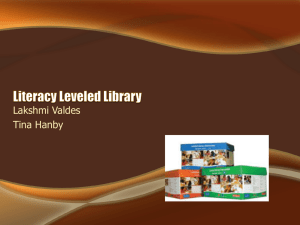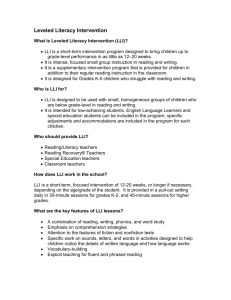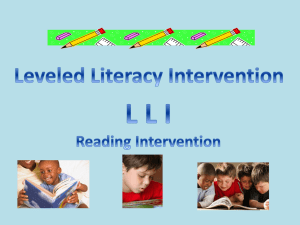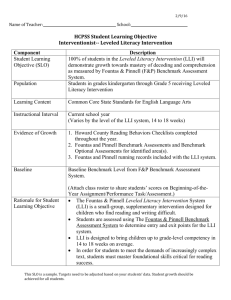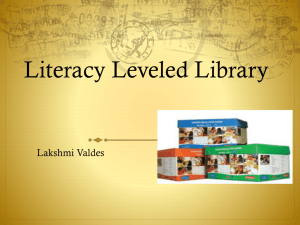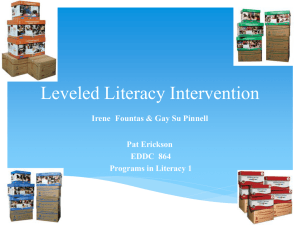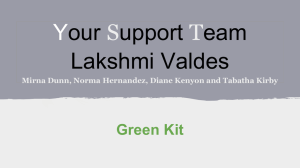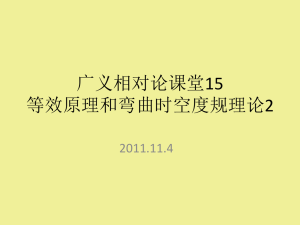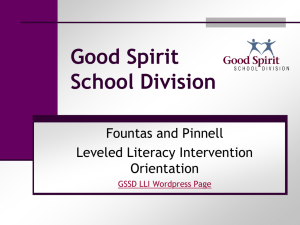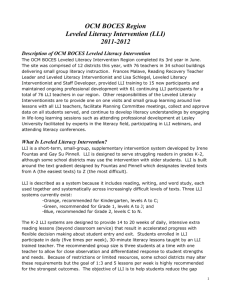OCM Region 2014-15
advertisement
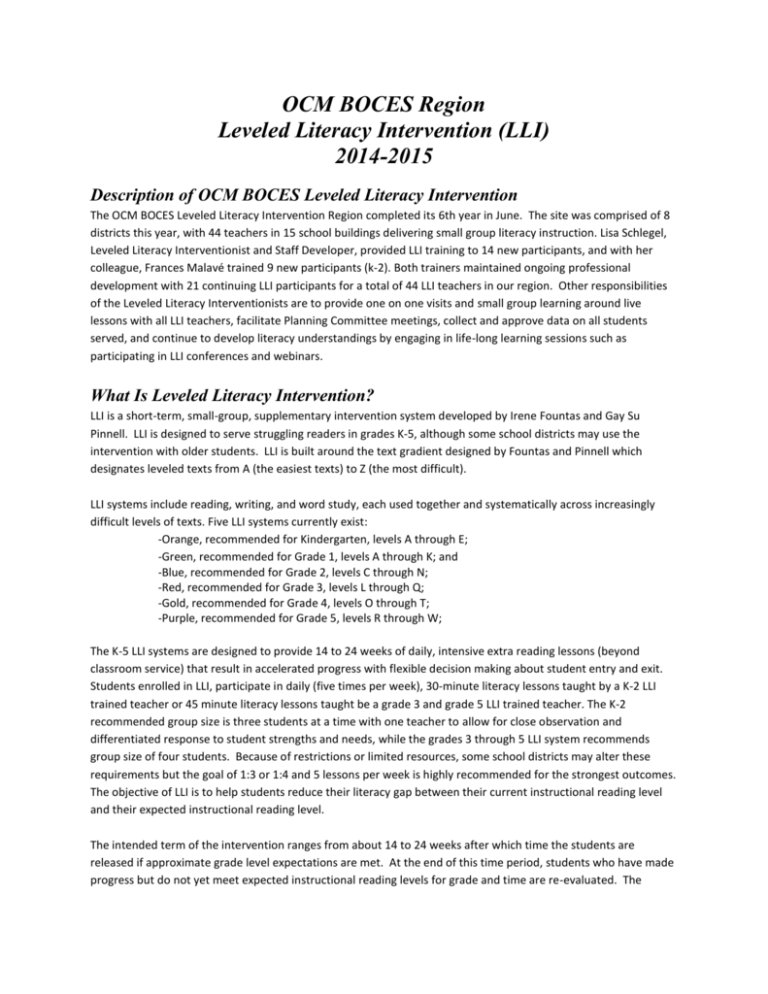
OCM BOCES Region Leveled Literacy Intervention (LLI) 2014-2015 Description of OCM BOCES Leveled Literacy Intervention The OCM BOCES Leveled Literacy Intervention Region completed its 6th year in June. The site was comprised of 8 districts this year, with 44 teachers in 15 school buildings delivering small group literacy instruction. Lisa Schlegel, Leveled Literacy Interventionist and Staff Developer, provided LLI training to 14 new participants, and with her colleague, Frances Malavé trained 9 new participants (k-2). Both trainers maintained ongoing professional development with 21 continuing LLI participants for a total of 44 LLI teachers in our region. Other responsibilities of the Leveled Literacy Interventionists are to provide one on one visits and small group learning around live lessons with all LLI teachers, facilitate Planning Committee meetings, collect and approve data on all students served, and continue to develop literacy understandings by engaging in life-long learning sessions such as participating in LLI conferences and webinars. What Is Leveled Literacy Intervention? LLI is a short-term, small-group, supplementary intervention system developed by Irene Fountas and Gay Su Pinnell. LLI is designed to serve struggling readers in grades K-5, although some school districts may use the intervention with older students. LLI is built around the text gradient designed by Fountas and Pinnell which designates leveled texts from A (the easiest texts) to Z (the most difficult). LLI systems include reading, writing, and word study, each used together and systematically across increasingly difficult levels of texts. Five LLI systems currently exist: -Orange, recommended for Kindergarten, levels A through E; -Green, recommended for Grade 1, levels A through K; and -Blue, recommended for Grade 2, levels C through N; -Red, recommended for Grade 3, levels L through Q; -Gold, recommended for Grade 4, levels O through T; -Purple, recommended for Grade 5, levels R through W; The K-5 LLI systems are designed to provide 14 to 24 weeks of daily, intensive extra reading lessons (beyond classroom service) that result in accelerated progress with flexible decision making about student entry and exit. Students enrolled in LLI, participate in daily (five times per week), 30-minute literacy lessons taught by a K-2 LLI trained teacher or 45 minute literacy lessons taught be a grade 3 and grade 5 LLI trained teacher. The K-2 recommended group size is three students at a time with one teacher to allow for close observation and differentiated response to student strengths and needs, while the grades 3 through 5 LLI system recommends group size of four students. Because of restrictions or limited resources, some school districts may alter these requirements but the goal of 1:3 or 1:4 and 5 lessons per week is highly recommended for the strongest outcomes. The objective of LLI is to help students reduce their literacy gap between their current instructional reading level and their expected instructional reading level. The intended term of the intervention ranges from about 14 to 24 weeks after which time the students are released if approximate grade level expectations are met. At the end of this time period, students who have made progress but do not yet meet expected instructional reading levels for grade and time are re-evaluated. The evaluation may suggest more time in LLI lessons or an alternative intervention (such as individual tutoring). Students who have not received a full program of services and are in the intervention at the end of the school year may continue to receive service at the beginning of the next school year. Some students who participate in the intervention may have achievement levels more than a year below grade level. Although these students may not achieve grade level performance in the short term, steady progress may warrant longer term service if resources allow for service to continue. Background on LLI Data Collection, 2014-2015: The data collection process and timing currently in place continues to assist the LLI Planning Committee members in consideration of the question: Is Leveled Literacy Intervention continuing to be an effective and efficient intervention in Central New York? There are two data collection tools used to capture the effectiveness for this program. Surveymonkey and Google Docs are tools used by LLI Teachers to document their students end results. Surveymonkey allows teachers to report on program data while the Google Docs spreadsheet provides teachers a way to report on student progress data. The data collected using the Google Docs spreadsheet was completed twice, mid-year and end of the year. All data was aggregated to create the regional profile. Individual district and teacher data is not analyzed here. If you are a planning committee member and would like the raw data to conduct further analysis specific to your district, please contact Lynn Radicello. Leveled Literacy Intervention Program Data Program data was reported for 208 LLI students taught by 15 LLI teachers in 10 schools through surveymonkey link. OCM BOCES LLI participants reported data voluntarily. There were 40 Total invitations 37.5% responded (15) 0% opted out (0) 5% bounced (2) 57.5% not responded (23) Leveled Literacy Intervention Teachers The table below shows the total number of teachers trained by OCM BOCES LLI Interventionists since 2009. Training by % of Teachers OCM BOCES Region 100% (n= 213)*combination of primary and intermediate trainings(a teacher can be counted twice) During the 2014-2015 school year, there were 44 LLI participants and only 15 teachers reported their Professional Title at their assigned schools through surveymonkey link. 73.33% (11) reported Reading Teacher as their primary title and 6.67 % (1) reported AIS as their primary title. The second highest percentage 13.3% (2) identified their title as Special Education Teachers. 6.67% (1) reported Classroom teacher. Teachers responded to what other role(s) they have in the school. 26.67%(4) have no other role, 46.67% (7)teachers identified as Title 1 or reading teachers, 17.9% selected special education teacher, 6.67%(1) participants were Reading Recovery Teacher, 6.67%(1) Classroom Teacher, (1) selected other(role not documented) none chose Reading Recovery, staff developers ,ELL, a School or District Administrator as their other role. Leveled Literacy Intervention in OCM BOCES region, 2014-2015 Summary Leveled Literacy Intervention Teacher’s Instructional Role Teachers provide powerful, daily small-group instruction for struggling readers and writers. Primary students in LLI participate in 30-minute, intensive lessons five days per week that combine reading, writing, and phonics/word study while the Intermediate students receive up to 45 minute, daily lessons. Teachers use a specially-created and sequenced set of original children's books, leveled A–N (primary) leveled L-W(intermediate), and use planned lessons that enable them to do highly effective and efficient teaching, resulting in accelerated student progress. In 2014-2015, 217 students were taught by 15 Leveled Literacy teachers. All teachers received professional development from 2 OCM’s literacy specialists. Results: 217 students were selected to receive Leveled Literacy Lessons Intervention daily. 43% (94) were females and 57% (123) were males. Survey shows that 40% of teachers filled an open slot when it occurred throughout the year, and there were 11% (24) of students’ had insufficient time to fully implement the service (full implementation is defined as 14-24 weeks of lessons). 11% (24) students had insufficient time for a full implementation of program .02% (4) student moved during the school year at the time of receiving Leveled Literacy service. 10% (21) students were recommended for an alternate intervention 18% (39) students’ programs were intended to be long term 21% (46) students made text leveled gains but did not reach benchmark 35% (77) reached benchmark Of the 217 students 187 students received a complete intervention which means 46% (86) students reached benchmark 59% (101) made progress but not sufficient to reach benchmark 14 Students reached benchmark less than 14-24 weeks of instruction. Of 14 Total Students With Special Needs 4 (29%) reached benchmark Appendix A The following are informal responses made about the LLI program from classroom teachers, administrators, parents and students. Leveled Literacy Intervention teachers shared: I continue to love the structure of the LLI lesson! Several teachers responded that Students improved drastically and it gave them the confidence they needed. Others Had no comment and wish the students had even more services Students (especially the 4th graders) often said "I can't wait to see what today's book is!" Students were extremely engaged with the texts. The non-fiction books in the Red Kit are phenomenal ! I had two students become so excited about two different books that they did research on the topics on their own at home! Isn't it just guided reading? One classroom teacher was concerned that small group instruction would not be as effective as Reading Recovery had been previously. My administrator was pleased with the progress made by several. "My child and I loved the books!" The books are amazing and so informative even to me as the parent! i love the books that are sent home to share! Teachers were happy to know progress and counted on being aligned with our group reading level and to look for carryover of skills. The students are making very good progress. This intervention helped 3 students’ achieve grade level. Like take home books I love these books! When can we read another Meli book? Students were sent back to the classroom not being on grade level because when benchmarking was done in the middle of year, there were kids who were lower in the classroom. http://www.heinemann.com/fountasandpinnell/lli_Overview.aspx, Leveled Literacy Intervention, Independent Gold Standard Study
